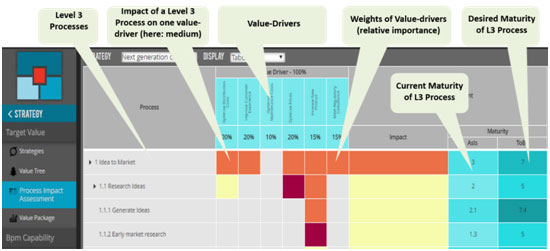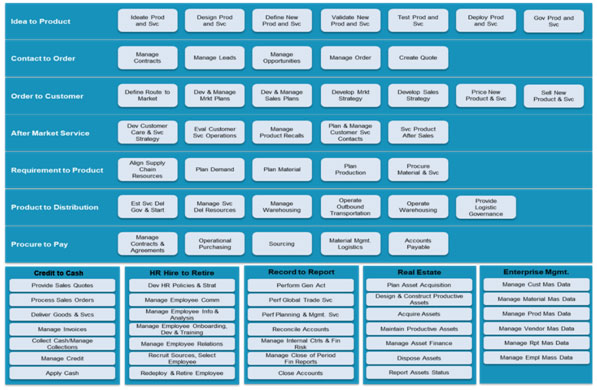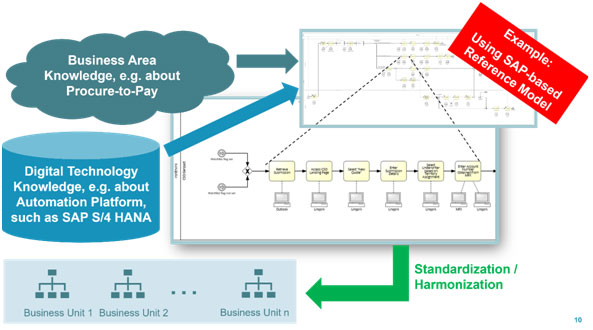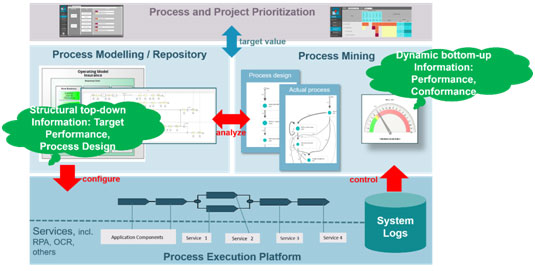Business Process Management is the Value-Switch for Digital Transformation
Organizations expect to increase their performance drastically by leveraging digital technologies [0][1]. However, many of those businesses struggle to meet the high expectations through their digitalization initiatives. They often don’t deliver the expected value.
A successful digital transformation is value-driven and guided through data-based decisions. It works towards a well-defined business case. The value of the transformation is delivered through new or enhanced business processes [2].Digitalization only delivers its business benefits if you improve what you do or if it helps to do something new that provides additional value. Hence, appropriate process management guides the transformation initiatives towards targeting and realizing value. To optimize the time-to-value, fast well-informed decisions are required. This is achieved through a data-based approach, delivering the required information about current and future process performance and conformance at pace in the required quality.
Businesses often focus on getting the technologies to work. They are proud of a successful “Proof of Concept” (POC) – even if it delivers no or minimal value. Many companies don’t master their processes sufficiently to realize the full potential of digital technologies [3]. They tend to automate and improve isolated functions, but miss their transformation goals and don’t deliver fully on the business case.
The right approach to digital transformation uses the discipline of process management as a value-switch and leverages process-related data effectively. The transformation approach is digitalized itself, using appropriate process management software, such as process modelling, simulation and process mining tools, as accelerators.
Focus on Value without boiling the ocean
Companies only compete through 15-20% of their processes [4]. Those processes are their high impact processes. The other 80%+ are commodity processes that are necessary, however, their performance can be at an industry average. High impact processes require in general more elaborated optimization and innovation approaches. Related projects have a higher priority. High impact processes that have a lower maturity level, compared to other organizations, are the best improvement targets. Digitalization initiatives that move those processes to the next performance level deliver most value for an organization [5].
It is key to identify the high impact low maturity processes to prioritize transformation initiatives appropriately. This is achieved through an assessment of the impact of each process on the business strategy, represented through appropriate value-drivers. The maturity of these high impact processes can be pragmatically determined through stakeholder surveys or through appropriate analytics tools. Results can be summarized in a process impact assessment matrix that creates the foundation to target best value during a digital transformation. It helps to focus on what matters most and avoids boiling the ocean. Prioritization and process insight tools as well as project portfolio management applications support this exercise [6]. Figure 1 shows an example of a process impact assessment matrix.

Improve in an End-to-End Process Context – based on appropriate Data
Once the processes in scope are identified, an efficient analysis is required. This detects improvement opportunities related to the defined value drivers and serves as input for the identification or confirmation of the digital technologies to be used. The results of the analysis are also the foundation for the development of the business case and simplify an effective people change management. To accelerate the analysis, process modelling and, if the as-is processes are sufficiently automated, also mining tools have become an increasingly important accelerator [6][7].They allow rapid remote discovery sessions, the necessary collaboration and the systematic collection of quantitative performance information.
To avoid fixing one issue while creating new ones in other sub-processes, an integrated end-to-end process view is required. The positioning of processes in the context of the overall operating model helps to identify other process areas and the touch points to those. The operating model of the company helps to work in an end-to-end context while keeping the scope manageable. An example for such an operating model design is shown in figure 2.
The to-be design of the processes in scope reflects the capabilities of digital technologies as well as their alignment with people involved in the process. It describes how the identified improvement opportunities can be realized and allows the finalization of the business case. Using techniques like customer journey mapping add an outside-in view on the process and its possible improvements.
Technology-based process reference models reflecting the business impact of digital technologies can be used as a starting point and powerful accelerator [8]. They simplify an enterprise-wide rollout and standardization of the transformed process. The content of process reference models for digital transformation is illustrated in figure 3. The reference to the end-to-end process and the links to other sub processes is maintained through the operating model context. The use of a process repository tool accelerates the collaborative development and roll-out of to-be processes as well as the use of reference models. The to-be process models define the top-down direction of the transformation.
The to-be models are the basis for the technology implementation as well as people change management[8] [11]. They help to align people and technology. Roles of people are often entirely redefined, for example to handle exceptions by people and have robots deal with routine standard cases.


The development and realization of a realistic business case requires quantitative information about the as-is and to-be processes, such as cost, time and scalability information or improved customer feedback ratings. Appropriate process management tools help deliver this information fast and reliably. A process modelling and repository tool allows simulations of the different processes. At an insurance company, for example, we could show that a to-be process for underwriting reduces over 80% of administrative work, almost half of the process cost and increases scalability by a factor 9. Process mining tools can provide process insights by analyzing system logs – if processes and sufficiently automated.
Sustain the Improvements and keep the Journey going
A digital transformation journey never ends. To sustain transformation results and keep the related business processes on track over time , a process governance approach is required. This defines how the performance of a process, and the success of a digital transformation is measured and managed after improvement projects have concluded [4][7]. It ensures the value-realization. Process-owners, for example, initiate new transformation initiatives or corrective actions when appropriate. Process stewards provide the arms and legs for the owners to enable the execution of activities. Process sponsors and governance bodies set the direction and resolve conflicts..
The work of process owners and the entire governance organization is supported through the to-be process models and with that a top-down direction, as well as process intelligence tools, especially process mining, which provide bottom-up information to control process performance and conformance with the design. Hence, the process owners know if the actual processes follow the design and deliver the expected value. They obtain the required information to set appropriate actions. Process governance goes through a digital transformation itself [9]. Figure 4 shows a simple digital tool architecture to enable fast well-informed decisions and define the required actions.

Business process management is established as the overarching management discipline [10][11]for the transformation and the following process governance. Thus,the BPM-Discipline becomes the value-switch for the digital transformation journey.
References
[0] Scheer, A.-W.: Unternehmung 4.0 – Vom disruptiven Geschaeftsmodell zur Automatisierung der Geschaeftsprozesse. Saarbruecken 2018.
[1] Kirchmer, M., Franz, P., Lotterer, A., Antonucci, Y., Laengle, S.: The Value-Switch for Digitalisation Initiatives: Business Process Management. BPM-D Whitepaper,Philadelphia – London, 2016.
[2] Kirchmer, M.: Value-driven Digital Transformation: Performance through Process. In: IM+io, Best & Next Practices aus Digitalisierung | Management | Wissenschaft, Heft 2, Juni 2019.
[3] Cantara, M:.Start up your Business Process Competency Center. In: Documentation of The Gartner Business Process Management Summit, National Harbor, 2015.
[4] Franz, P., Kirchmer, M.: Value-Driven Business Process Management: The Value-Switch for Lasting Competitive Advantage. 1st ed., McGraw-Hill, New York 2012.
[5] Kirchmer M., Franz, P.: Targeting Value in a Digital World. BPM-D Publications, Philadelphia, London, 2014.
[6] Kirchmer, M., Franz, P., Gusain, R.: From Strategy to Process Improvement Portfolios and Value Realization:
A Digital Approach to the Discipline of Business Process Management. In: Proceedings of the Eighth International Symposium on Business Modelling and Software Design, Vienna, 02-04 July 2018.
[7] Kirchmer, M.: High Performance through Business Process Management –Strategy Execution in a Digital World. Springer, 3rdedition, New York, Berlin, e.a. 2017.
[8] Kirchmer, M., Franz, P.: Process Reference Models: Accelerator for Digital Transformation. In: Shishkov B. (eds) Business Modeling and Software Design. BMSD 2020. Lecture Notes in Business Information Processing, vol 391 (ISBN: 978-3-030-52305-3). Springer, Cham.
[9]Kirchmer, M.: Digital Transformation of Business Process Governance. In: Shishkov B. (eds) Business Modeling and Software Design. BMSD 2021. Lecture Notes in Business Information Processing, vol 422 (ISBN: 978-3-030-79975-5). Springer, Cham.
[10] Kirchmer, M., Franz, P.: The Process of Process Management – Strategy Execution in a Digital World. BPM-D Publications, Philadelphia, London, July 2015.
[11] Antonucci, Y., Fortune, A., Kirchmer, M.: An examination of associations between business process management capabilities and the benefits of digitalization: all capabilities are not equal. In: Business Process Management Journal, Vol. ahead-of-print No. ahead-of-print, https://doi.org/10.1108/BPMJ-02-2020-0079, 2020.
BIO:
Dr. Kirchmer is an experienced practitioner and thought leader in the field of Business Process Management (BPM) and Digital Transformation. He co-founded BPM-D, a consulting company focusing on performance improvements and appropriate digitalization by establishing and applying the discipline of BPM. Before he was Managing Director and Global Lead of BPM at Accenture, and CEO of the Americas and Japan of IDS Scheer, known for its ARIS Software and process consulting.
Dr. Kirchmer has led numerous transformation and process improvement initiatives in various industries at clients around the world. He has published 11 books and over 150 articles. At the University of Pennsylvania and at Widener University he has served as affiliated faculty for over 20 years. He received a research and teaching fellowship from the Japan Society for the Promotion of Science.
E-Mail: mathias.kirchmer@bpm-d.com
Phone: +1-484-557-6794
Address: 475 Timberline Trail, West Chester, PA 19382, USA